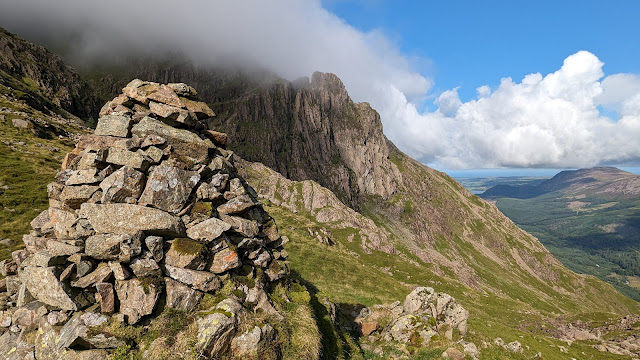The Mell Fells
TWO Wainwright walk: Great Mell Fell and Little Mell Fell (strictly speaking, two separate short walks with a two mile car drive in between!)
Walk Rating:⭐⭐
Time: 1 hour for Great Mell Fell, half- an-hour for Little Mell Fell.
Parking: For both walks, limited free parking on the roadside. For Great Mell Fell, around the end of the track near Brownrigg Farm (Grid Reference NY 407247). For Little Mell Fell, at 'The Hause' (Grid Reference NY 423235).
 |
| Great and Little Mell Fells from above Matterdale End |
Great and Little Mell Fell, two rounded hills on the north-eastern fringes of the Lake District National Park, are both listed in Wainwright's "Guide to the Eastern Fells", even though Wainwright himself seems to question whether Little Mell Fell, in particular, fully warrants inclusion.
It was for Wainwright to decide why both Mell Fells made it onto his final list of 214 fells, when much greater summits such as Scafell Pike's Ill Crag and Broad Crag, and Helvellyn's Lower Man, never did. So they demand a visit, by taking a car along the minor roads from Matterdale End, in order to take a short, although not entirely gentle, walk to their grassy tops.
 |
| Strava estimates there-and-back walking distances of 3km for Great Mell Fell, and 1km for Little Mell Fell (although the gradient is over 30% at times) |
Great Mell Fell
1. Hopefully you can successfully find a place to park your car amongst the dog-walkers. Now head up the obvious track heading from the road to the bottom of the wooded hill. You will soon reach a gate on the right with a National Trust sign for "Mell Fell". This is NOT the best route to take. Although it could be taken, or perhaps used as a variation on return, the way up from here can be very wet and slippery.
 |
| Ignore the route through this gate |
2. Instead, it's best to head on up the lane a few hundred metres more until another gate is seen on the right. Cross the stile and head along the path going up and to the left of the woods.
 |
| Instead, head over this stile |
3. The path ascends the slope, bending to the right as it climbs fairly steeply. Then head left up to the patch of trees further up the fell.
 |
| Head up towards the trees |
4. Make you way through the trees and then, as the gradient subsides, walk on to the grassy summit area. These two views of the hill will give you an idea of the profile of your walk:
 |
| Great Mell Fell from the south-west (from the road to Troutbeck) |
 |
| Great Mell Fell from the south-east (from the road to Brownrigg) |
 |
| On the top of Great Mell Fell |
6. Return the way you came. The rounded shape of Little Mell Fell will be in front of you, to the south-east, as you descend.
 |
| Little Mell Fell to the south-east |
7. Walk past the wind-blown and weathered trees that still grow on the hillside, unusually for a Lake District fell. Then descend to cross the stile again into the lane, then head left, back to your parking place.
 |
| Return the same way as you came up |
Little Mell Fell
Few instructions are needed once you've found a place to leave the car on 'The Hause', and have made your way across the field to the bottom of the fell:
1. Walk up the fell (steeply!) using the steps cut into the turf by previous walkers.
 |
| Going Up |
2. Find the Ordnance Survey column (and, if it's the reason you're here, tick-off Little Mell Fell (1657') on your list of successfully climbed Wainwrights!)
 |
| Looking towards Penrith from the top of Little Mell Fell |
3. Retrace your steps, back to 'The Hause'.
 |
| Going down |

